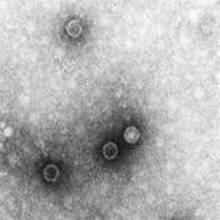An outbreak of imported wild-type poliovirus in China was interrupted within 6 weeks of laboratory confirmation of the index case, thanks to an immediate, potent public health response that accorded with World Health Organization recommendations, according to a report published online Nov. 21 in the New England Journal of Medicine.
The last indigenous wild-type poliovirus in China was isolated in 1994, and the country was certified as poliomyelitis free in 2000. This strain of the virus was traced back to Pakistan, which, along with Afghanistan and Nigeria, are the only countries in the world that have failed to control transmission of wild-type poliovirus, said Dr. Hui-Ming Luo of the Chinese Center for Disease Control and Prevention, Beijing, and associates.
"Until wild-type poliovirus transmission is interrupted globally, poliomyelitis-free countries will continue to be at risk for viral importation," they wrote.
In this outbreak, the index case was a 16-month-old girl whose family had no history of travel beyond southern Xinjiang province. She was hospitalized for flaccid paralysis, and an epidemiologic investigation began immediately. Three more cases of flaccid paralysis were identified in the same county, and the Chinese CDC confirmed that the same strain of wild-type poliovirus was present in all cases and that it had been imported from Pakistan.
All together, 21 cases of infection were confirmed and 23 clinically compatible cases were reported in southern Xinjiang. A single sewage sample from the index case’s hometown and another from a sample of river water there were found to be positive for wild-type poliovirus type 1.
"The incidence rates of wild-type poliovirus infection and clinically compatible poliomyelitis were highest among children younger than 1 year of age (3.46/100,000 and 1.15 cases/100,000 population, respectively)", they reported. Just under half of the 21 infections were in children under age 14 years.
The virus was isolated from 14 of 673 (2.1%) healthy people who were in contact with the affected patients and from 13 of 491 (2.6%) healthy people who were not in contact with any patients.
The national and local governments responded according to the 2006 World Health Assembly resolution on such outbreaks: they launched an investigation within 72 hours; conducted five rounds of supplementary immunization, beginning within 4 weeks of the start of the outbreak and continuing after the last cases were reported; surveyed and found that the coverage rates for all five rounds were greater than 95%; and enhanced the surveillance for acute flaccid paralysis throughout the affected province.
"Key response measures were the declaration of a public health emergency, enhancement of the sensitivity of surveillance for acute flaccid paralysis, the conduct of epidemiologically targeted vaccination campaigns, the use of monovalent OPV1 [oral poliovirus vaccine] for two rounds of supplementary immunization, close collaboration with international agencies such as the WHO and the U.S. Centers for Disease Control and Prevention, and provision of adequate resources to mount the response," the investigators said (N. Engl. J. Med. 2013 Nov. 21 [doi:10.1056/NEJMoa1303368]).
This effort was estimated to have cost the equivalent of $26 million U.S. dollars and required more than 500 public health experts to assist the local health workers, government officials, and approximately 500,000 volunteers who were involved.
"The global eradication of poliomyelitis will benefit all countries, including those that have been certified as poliomyelitis-free," the researchers wrote.
No financial conflicts of interest were reported.


